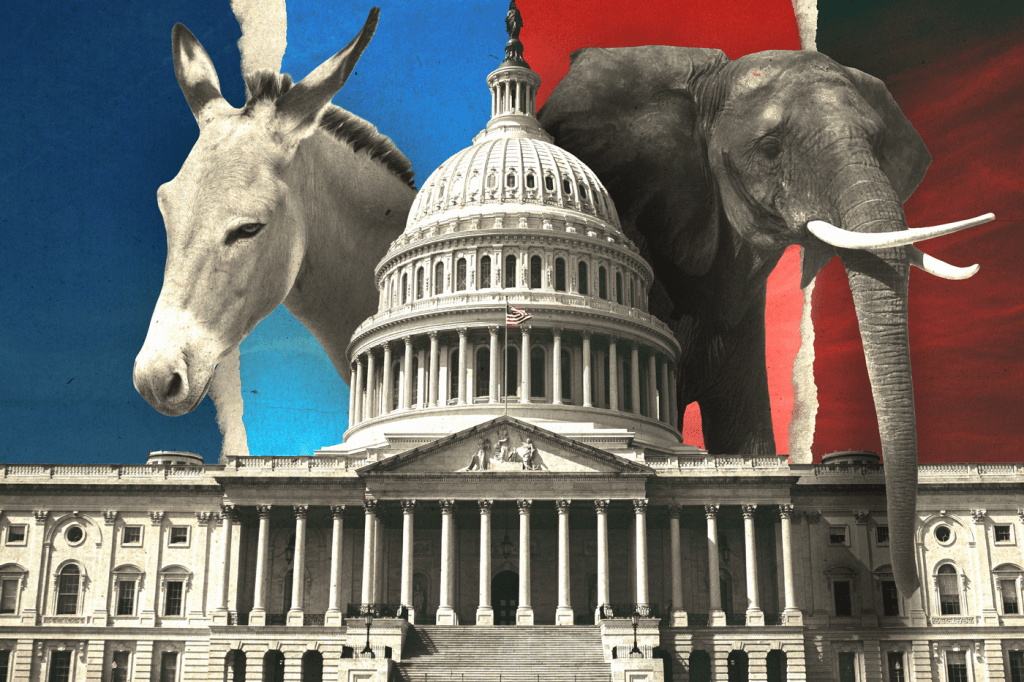Is the US now a four-party system? Progressives split Democrats, and far-right divides Republicans

For several decades now, political scientists have been carefully documenting the disappearance of the “political middle” among the ranks of both the Democratic and Republican parties in Congress.
The phenomenon, often referred to, with slight variation, as the “shrinking of the center,” is by no means specific to U.S. politics. But what the latest debt ceiling deal illustrates is that even as the schism between party lines deepens, political divisions within the two entrenched parties are perhaps just as significant as those across them, Northeastern political scientists say.
“Negotiations like these reveal just how strongly the shrinking of the middle has materialized in Congress, I think,” says Costas Panagopoulos, head of Northeastern’s political science department. Intraparty strife is certainly nothing new; but research suggests that the diversity of viewpoints held by voters and their elected officials increasingly does not conform to the two-party dynamic.

Following the 2021 midterm elections, Pew Research Center attempted to flesh out these intraparty factions and the ideological positions they correspond with. The result was a political spectrum divided into a whopping nine groups based on surveyed attitudes and values—a highly granular look at the fractured political landscape of the 2020s.
But much of the media have tended to portray U.S. politics over the last decade or so as comprising four distinctly identifiable camps: establishment liberals, the progressive (or far) left, center-right conservatives and the far-right. Polling data over the last couple of years supports the idea that the two main parties have undergone further fragmentation, which Panagopoulos says may reflect the ideological evolution of their respective bases.
“It’s been very clear, particularly with the GOP, that as the moderate wings have been shrinking, the bases of both parties have become more important,” Panagopoulos says. “But that does not mean that moderate voters should be overlooked in elections because in tight races, history has shown that they can make a difference.”
Indeed, the four factions “can easily be discerned” in the four formal caucuses within the House of Representatives, says Nick Beauchamp, associate professor of political science at Northeastern.
Those four caucuses include—from the ideological left to the hard-right—the Congressional Progressive Caucus, with 99 members; the New Democrat Coalition, with 94 members; the Republican Study Committee, with 156; and the House Freedom Caucus, with 53 members.
The debt ceiling crisis—resolved last week after members of both parties found common ground on a legislative package to avoid a default—was a prime venue for witnessing the four-faction dynamic play out, Panagopoulos and Beauchamp say. The House and Senate votes on the package saw holdouts from the more extreme wings of both parties—a stark contrast to the deal struck in 2021 that closely followed party lines.
Political circumstances have changed since the last crisis—including the balance of power in Congress, which may have enabled more lawmakers to take a principled stand on certain budgetary issues without compromising the overall vote, Panagopoulos says. This year’s bipartisan deal was brokered by President Joe Biden and House Speaker Kevin McCarthy, a Republican whose own bid for the speakership went through 15 rounds of voting after far-right members objected to the majority’s pick.
Some observers found the compromise baffling given the heightened rhetoric surrounding a potential debt default. To many others, last week’s vote was a clear indication of the deepening divisions within the two parties.
“It’s not unusual for ideological orientations in the legislature to shift, while still falling under the banner of one or another party,” Panagopoulos says.
“But this is partly a reflection of the structure of a two-party system in which, whatever differences there are, at the end of the day, they have to be reconciled under the umbrella of one major party,” Panagopoulos adds.
Roughly half of the Republican 71 no-votes in the House were members of the Freedom Caucus, the far-right arm of the GOP. Forty-seven House Democrats joined in the opposition, including progressives such as Reps. Alexandria Ocasio-Cortez and Pramila Jayapal.
A number of high-profile Senate Democrats and former Democratic presidential candidates voted against the reconciliation package, including John Fetterman, Elizabeth Warren, Ed Markey and Bernie Sanders.
On the Republican side, Josh Hawley, Lindsey Graham and Ted Cruz were among the 36 Republican senators to oppose it. They broke with “Old Guard” conservatives, such as Senate Minority Leader Mitch McConnell and the even-more-moderate Mitt Romney.
The narrow majorities both parties enjoy in the House (Republicans) and Senate (Democrats) highlight just how politically impactful the four-faction dynamic has become.
“More generally, this bill was one of an increasing number of bills over the last few years that have passed with bipartisan coalitions, objected to by both wings,” Beauchamp says. “However, it should be noted that ‘bipartisan’ and ‘centrist’ are relative terms: relative to the recent past.”
“Even the center-right [Republican Study Committee] is well to the right of where it once was, and the [New Democrat Coalition] is likewise somewhat to the left—especially on social issues—from where it once was,” Beauchamp continues. “So we might expect bipartisan bills to be rare, but despite that the wings are also more extreme so bipartisanship continues.”
Tanner Stening is a Northeastern Global News reporter. Email him at t.stening@northeastern.edu. Follow him on Twitter @tstening90.






